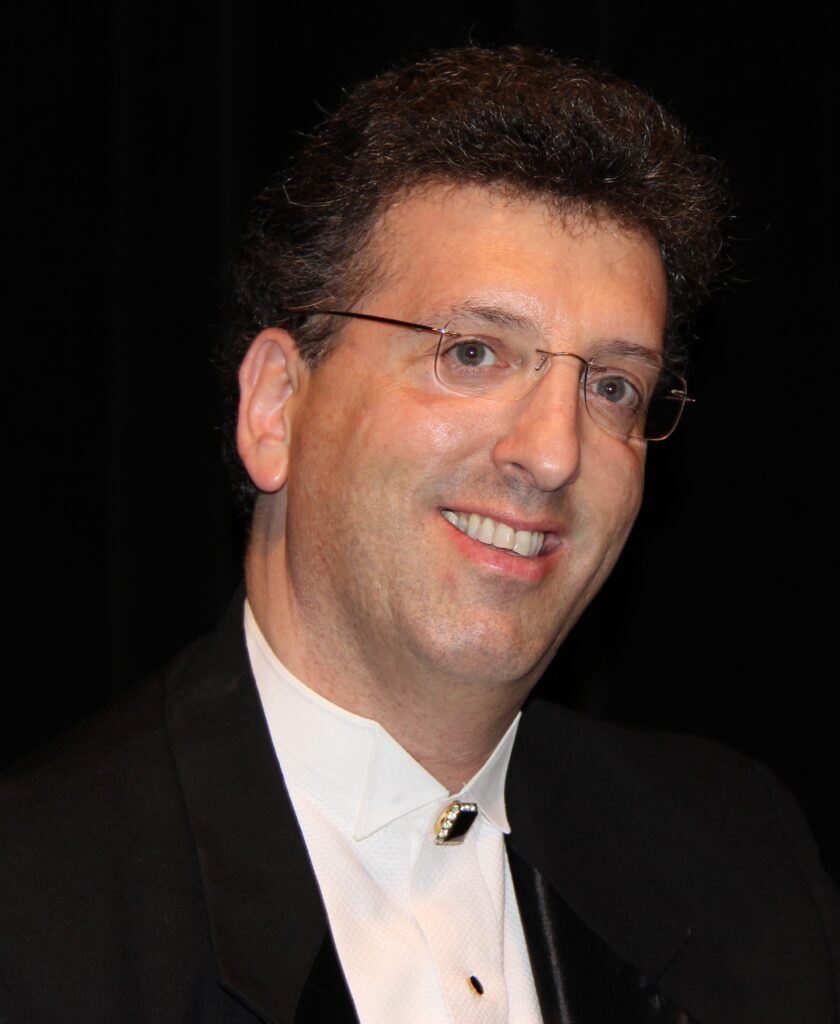A tale of two rhapsodies, delivered with jazzy panache by Biegel, Fairfax Symphony

Pianist Jeffrey Biegel performed music of Gershwin and Peter Boyer Sunday with the Fairfax Symphony Orchestra. Photo: Mark Lerner
Pianist Jeffrey Biegel, an indefatigable champion of contemporary music, wanted to celebrate the centennial of the premiere of George Gershwin’s Rhapsody in Blue in 1924 by performing a new work alongside it. He came up with the title Rhapsody in Red, White and Blue before he had found a composer, and conceived a campaign to perform both rhapsodies in all 50 states, as a way for our nation to “join hands through music, despite all the divisions and differences.” (Would that classical music actually had enough cultural clout to solve all our problems!) Biegel then persuaded Peter Boyer, who has received acclaim for his patriotic compositions, to create something that could stand alongside Gershwin.
The tour reached the George Mason Center for the Arts on Sunday afternoon, as the Fairfax Symphony Orchestra, under music director Christopher Zimmerman presented the regional premiere of Boyer’s rhapsody. The FSO was the 21st orchestra to perform both rhapsodies together, and Virginia is the 19th state on the new rhapsody’s cross-country journey.
Though Boyer’s work shares a program and most of its title with Gershwin’s, its aesthetic is all Boyer, beginning with a fanfare blazing loud in the brass and percussion. Biegel’s piano comes in to question the fanfare for a moment, but soon that driving tune reappears, in more muted orchestral garb. Some jazz-inflected music nods to the earlier rhapsody, then the pace slows to allow Biegel to present a big, unabashedly romantic tune, soon taken up by the orchestra; a moment of magic happens when the tune blossoms in the strings with a warm halo of vibraphone tones underneath. Boyer cranks things back up in the final pages, closing on a heroic tune that sounds like something from a lost John Williams score.
For the most part, Boyer’s Rhapsody in Red, White and Blue sits in the major mode and moves briskly from incident to incident; at 17 minutes, it could use a few more moments of tension or uncertainty. It felt both rousing and a little superficial on Sunday, even in this excellent performance, with Biegel a thoroughly committed advocate and the Fairfax SO playing vividly and energetically throughout. (Interested listeners can judge for themselves by listening to a recording with Boyer conducting the London Symphony Orchestra, and Biegel of course as soloist.)
By contrast, Gershwin’s rhapsody, performed before Boyer’s on Sunday, thrives on uncertainty, its influences constantly jostling for position; its big tune comes in unexpectedly, and interweaves with the rest of the work until it comes back even bigger at the end, thus allowing United to sell a lot of plane tickets years later.
Sometimes orchestras sound stiff in the jazz portions of Rhapsody in Blue, but under Zimmerman the FSO both played together and sounded relaxed and free throughout, beginning with principal clarinet Patrick Morgan’s swaggering glissando to open the work. The musicians made the initial entrance of the big tune hushed and haunting and provided hand-in-glove support to Biegel.
As the piano plays both solo and rhythm in jazz, Biegel used a more percussive tone in the Gershwin than in the Boyer, and flitted among the jazz, Cuban, and other influences with ease. Biegel plays the piano part from the 1924 edition of Rhapsody in Blue, which features several dozen bars that Ferde Grofé cut when preparing the 1942 orchestral edition that is commonly performed, and the additional music is a real treat, helping to bolster the narrative of this episodic work.
To begin the program, Zimmerman led the FSO in Amy Beach’s Symphony in E minor, “Gaelic,” the first symphony composed and published by an American woman in 1896. It owes a debt to Antonín Dvorák but has some individual touches that make for an entertaining work.
After a tense but unmemorable first movement, the second movement alternates sunny, relaxed music with frothy dance tunes; at one point, the faster music whips itself into a frenzy and comes to an abrupt pause before the slower music returns, a fine jest brought off well by Zimmerman and the FSO.
A slow movement marked “Lento con molto espressione” puts two fetching melodies in counterpoint, introduced eloquently on Sunday by concertmaster Allison Bailey and principal cello Natalia Vilchis. The FSO’s winds distinguished themselves throughout, but especially in this movement, as solos shimmered with rich colors.
In the Allegro di molto finale, the music starts with a propulsive melody and slows down for yet another fetching theme. Zimmerman and the FSO adeptly navigated the twists and turns that led to the closing major-mode catharsis.
The Fairfax Symphony Orchestra’s 2024-2025 season opens October 19 with the U.S. premiere of Elena Kats-Chernin’s “Force Majeure” for piano and orchestra, alongside music by American composers. fairfaxsymphony.org


